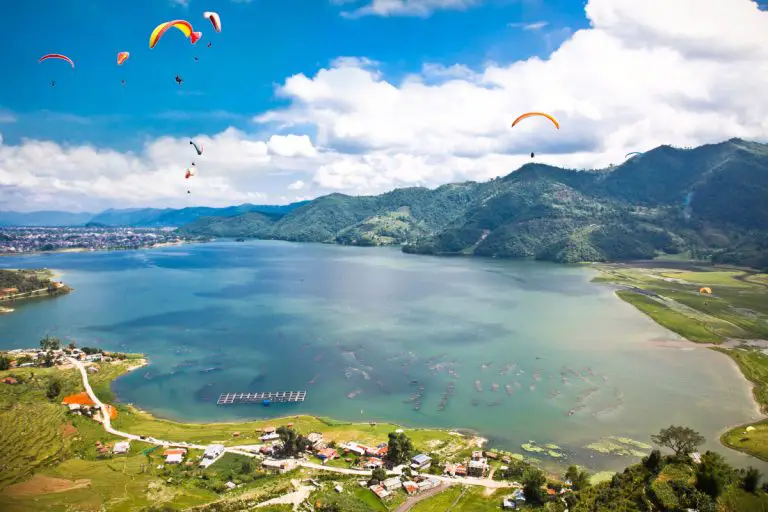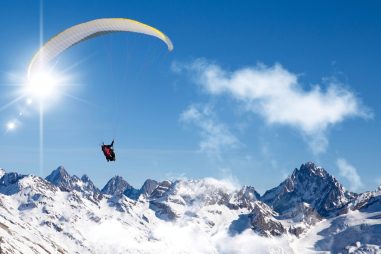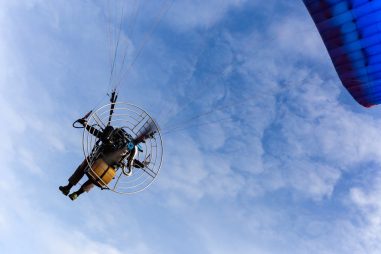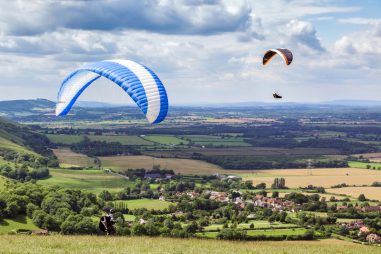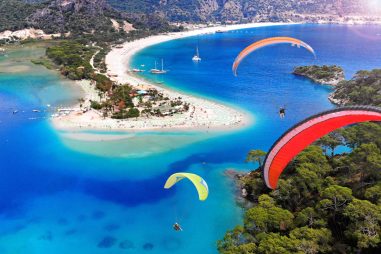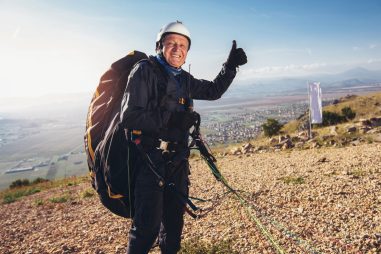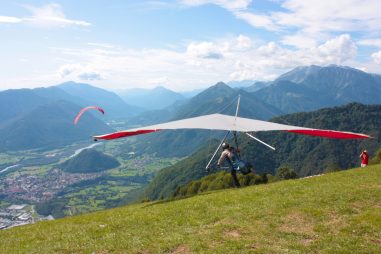The range of a paraglider may vary depending on the kind of equipment you are using and the class of your wing. Paragliders for beginners are usually used for training and short flights. Paragliders for more advanced and experienced pilots typically have a more excellent range that can fly for prolonged periods of time.
How High Can a Paraglider Fly?
Paragliders can fly as high as 18,000 feet (5,500 meters) to 23,000 feet (7,000 meters) or even more. Many describe paragliding as the most basic form of human flight because it does not have a motor and is usually launched on foot. You can fly a paraglider at much higher altitudes as long as your equipment can handle it and you observe safety throughout your entire flight.
Ramon Morillas Salmeron flew over Masherbrum Peak in 2009, holding the world record for flying a paraglider at 25,660 feet (7,821 meters). He dedicated much of his time and effort to various kinds of aviation, such as paragliding, paramotoring, free flight, and aerial exploration from 1997 until today. He is famous for his numerous achievements and contributions to the wonderful world of flying.
How High Do You Normally Go When Paragliding?
The average height you can reach when paragliding is usually 15,000 feet (4,572 meters), but you can always go higher than this if you have the ability to. You will stay aloft high up in the sky with the birds, which typically lasts 3 hours or longer.
Pilots make use of air currents known as thermals to maintain altitude. It allows them to cover great distances when going on cross-country flights for a unique experience.
Several factors affect your flight when paragliding, such as the weather conditions, physical ability, and experience. It is best to take it easy on your first paragliding flight and avoid going on altitudes above your skill level, especially if you are a beginner. You can increase the intensity of the flights you wish to experience if you have a strong desire to take this thrilling sport more seriously.
Which Is the Highest Paragliding in the World?
The highest paragliding spot across the globe is Mt. Everest, the tallest mountain in the world. Pierre Carter is the first paraglider to make a legal flight off Mount Everest after gaining a permit from the government of Nepal. The conditions of the permit stated that he could not go further than 26,000 feet (8,000 meters) and take off from the peak of Mt. Everest.
He decided to launch his paraglider at South Col, which is very close to the summit at an altitude of almost 26,000 feet (8,000 meters). His flight lasted for about 20 minutes, and he reached speeds of up to 50 mph (80km/h) before reaching his destination. Then, he flew around the snowy peaks of the Himalayas and landed in a little place in Gorak Shep at an altitude of 16,942 feet (5,164 meters).
Where Is the World’s Highest Paragliding Spot?
As mentioned above, the world’s highest paragliding spot is Mt. Everest, but this is not really a famous destination for pilots since taking off from here is not legal. You have to get permission from the government of Nepal before you can paraglide off Mt. Everest. However, you can still paraglide off Everest if you are willing to get the necessary permits to fly legally.
The second highest paragliding spot in the world and the highest in Asia is Bir Billing, Himachal Pradesh, India. Pilots take off from the most popular spot in Billing, which stands at a great height of 8,000 feet (2,438 meters). This is truly a magnificent paragliding destination. It offers endless thrilling activities as you enjoy the beauty of India’s nature.
How Far Can You Go With a Paraglider?
A paraglider can fly hundreds of kilometers without an engine for many hours, which is very thrilling. You can fly to any destination you desire to visit as long as you do not break any laws. As a matter of fact, paragliding is an active sport that can take you to other countries.
However, always proceed with utmost caution to stay away from unwanted mishaps. It is possible to encounter other aircraft while you are flying in the air.
According to the Fédération Aéronautique Internationale (FAI), the world distance record holder was Ramon Morillas Salmeron when he successfully flew over the Atlantic Ocean in 2007 and covered a total distance of 1,105 kilometers (686 miles). He started his flight from Jerez, Cadiz, and landed in Lanzarote, Canary Island, Spain.
Ramon Salmeron is well known for taking his flights to extreme degrees and is still recognized as an elite athlete up until the present time.
How Far Can You Paraglide in a Day?
You can paraglide for hundreds of miles in a day by going on cross-country flights. Paragliding flights can last a lot of hours and cover far distances even if it does not use an engine. Recreational flights usually last for about 2 to 3 hours, covering some tens of kilometers but can also last for 6 to 8 hours or even more.
Paragliding requires you to be fit because it can tire the body when flying for long durations. You must also be mentally prepared to think with a clear mind. This is because you might encounter obstacles during your flight that will need you to make the right decisions. Getting better at paragliding is a journey; you must put in a lot of hard work to progress in this sport.
What Is the Average Speed of a Paraglider?
The average speed of a paraglider can range somewhere around 20 to 75 km/h (12 to 47 mph), but this can vary due to several factors. Thermals, weather conditions, wings, and the pilot’s weight are some factors that impact the speed of a paraglider. You must also always remember to only fly at speeds you can handle to stay safe at all times and avoid any accidents.
If you are a newbie using beginner wings, you will have a slower speed. On the other hand, you will have a much faster speed if you are quite experienced and capable of using high-performance wings. There is no shame in going slow at first if you are a beginner because you can always work your way up from there with each paragliding trip you go on.
How Fast Can a Paraglider Go?
A paraglider can go as fast as 75 km/h (47 mph), but this is not an easy feat to achieve. You need to use high-performance competition wings to reach fast speeds like this. Beginner pilots will have a difficult time controlling competition-class wings which is why only advanced pilots should use these types of wings. High-performance wings are hard to control, requiring you to have enough knowledge and experience to be capable of using them.
Most pilots who fly their paragliders at fast speeds like this had spent lots of hours flying in the air before they were able to fly at incredible speeds. The good news is it is also possible for you to accomplish this if you dedicate more time and effort to paragliding to get better in this fantastic sport.
With that said, keep in mind that you should never fly at speeds beyond your skill level to have a safe and enjoyable flight.
What Is the Fastest Paraglider?
The Ozone R11 is known as the fastest paraglider ever built and is documented to have a maximum speed of 65 km/h (40 mph).
The Ozone R11 is stable, comfortable, easy to use, and collapse resistant, which provides you with outstanding performance at fast speeds. However, advanced pilots should only use the Ozone R11 because it is still difficult to handle for beginners even though it is easy to use.
The fastest paragliders have a high aspect ratio designed for performing long glides and going at fast speeds. You are able to fly at faster speeds if your wings have a higher aspect ratio, but it is more challenging to maneuver. These paragliders are competition class which is usually a Civil Competition Class (CCC), commonly known as EN D Class, in older models of wings.
What Is the Glide Ratio of a Paraglider?
The glide ratio of a paraglider shows how much distance a glider can cover or travel when it falls. Paragliders with recreational wings have a glide ratio of 6:1 to 9:1, while paragliders with competition class wings have a glide ratio of 13:1.
A glider with a glide ratio of 6:1 will cover a distance of 6m for every 1m that it goes down or loses height (6 ft every 1 ft drop). In simpler words, the minimum sink rate of a glider is the lowest possible sink rate that can be attained or the smallest amount of height loss per unit of time.
The formula for obtaining the glide ratio of a paraglider is the horizontal distance covered divided by the vertical distance lost. A glider with a better glide ratio will be more efficient in traveling far distances while not losing a lot of height. Understanding the concept of a paraglider’s glide ratio is essential so you can get the best performance out of your glider when flying in the sky.
How Fast Does a Paraglider Fall?
A paraglider can fall as fast as 5m/s to 6m/s (16 to 20 ft/s) depending on the kind of collapse that happened and other factors that caused you to fall.
There are numerous reasons for a paraglider to fall, and the most common is the occurrence of what is widely known as collapse. A collapse often happens due to pilot error, equipment malfunction, or flying in extreme turbulence.
Different types of collapse could happen when you are paragliding. This includes wing collapse, asymmetric collapse, negative spin, and parachutal stall.
Collapses happen, but they can certainly be avoided by prioritizing safety at all times to stay away from harm. With that said, accidents also occur, but you must remain calm if your paraglider collapses because it is possible to recover from this.
What Is the Sink Rate of a Paraglider?
The sink rate of most modern LTF 1 to LTF2 (EN-A to EN-C) wings is about 1.1 m/s which is around 220 ft./min when flying without braking or “hands-up.”
Sink Rate is how much altitude you lose in a particular period of time, such as how many meters per second or how many feet per minute. It is known as the speed with which a body loses altitude or, more particularly, the rate at which a glider loses altitude when in flight.
A sink rate of about 1.0 m/s (200 ft./min) is the most that a paraglider could have before it would limit the times where a gaining altitude was achievable to only when there was strongly rising air.
It can be a little challenging to understand the sink rate of a paraglider at first, but you will slowly get it eventually. You will surely not regret taking your time and putting effort into learning this concept because it will be very useful during your flight.
What Is Minimum Paragliding Sink Rate?
Gliders are designed for sustained flight and have minimum sink rates ranging between 0.4 to 0.6 m/s (78 to 118 ft/min) depending on their class. The minimum sink rate of a glider is the absolute lowest possible sink rate that can be achieved or the smallest amount of height you lose in a specific amount of time. In simpler words, the minimum sink is the lowest sink rate you can possibly have.
The minimum sink rate in paragliding is the minimum vertical speed a glider can fly within still air, which is usually 0.5 to 1 m/s (100 to 200 ft/min). The minimum sink is attained when flying at a particular speed in the air, but this greatly varies depending on what kind of glider you are using. Here are the different types of paragliders that also affect your minimum sink rate:
- First Paraglider
- Progression Class Paraglider
- XC Class Paraglider
- Sports Class Paraglider
- Performance Class Paraglider
- Competition Class Paraglider
How Long Can Paragliders Stay in Air?
The average time that paragliders usually stay aloft is about 3 hours or more. You can keep flying your paraglider in the air for up to 8 hours if you make use of air currents known as thermals. You can also fly a paraglider for a much longer time by taking advantage of prevailing winds blowing up a slope. Paragliders can stay flying in the air as long as lift is available.
You must also take a few factors into consideration before going on a paragliding trip. Your expertise, experience, capabilities, and weather conditions matter.
It is advised that you take short and easy trips if you are new to paragliding. Then, gradually increase the duration and intensity of your flights as you gain more experience flying.
What Is the Longest Paraglider Flight?
The longest paraglider flight was done by Ramon Morillas Salmeron in 2007 when he flew 1,105 kilometers (686 miles) over the Atlantic Ocean using his Advance Omega 7 Paraglider.
The second record holder is Sebastien Kayrouz, who achieved flying a distance of 612 km (380 miles) back on the 19th of June 2021, according to the FAI. He launched his paraglider a few miles away from the Mexican border near the town of Del Rio and Brackettville. He landed in Amarillo, Texas, after flying for almost 11 hours using his Ozone Enzo 3 paraglider.
Sebastien Kayrouz succeeded in going over the 600 km mark (373 miles), which is not an easy feat to accomplish. His flight is remarkable as he flew with an average speed of approximately 60 km/h (37 mph) and reached altitudes between 3,280 to 6562 feet (1,000 to 2,000m). He beat the 582 km (363 miles) record set on October 10, 2019, by the Brazilian trio Rafael Saladini, Marcel Prieto, and Rafael de Moraes.
Which Town Is Famous for Long-Distance Paragliding?
Queenstown, New Zealand, is a town on the South Island famous for long-distance paragliding because of its remarkable geography. It is popularly regarded as the adventure capital of New Zealand due to the many thrilling adventure sports you can do here. You can do many activities here, such as skiing, hiking, jet boating, bungee jumping, whitewater rafting, and much more.
The unique geography of Queenstown offers you breathtaking sceneries as you fly in the air surrounded by the range of the Southern Alps. The winds and thermals coming from the mountains make it possible for you to paraglide for extended periods of up to eight hours.
Paragliding can be done in Queenstown all year round, but winters can be freezing, so make sure to wear appropriate clothing to keep you warm.

